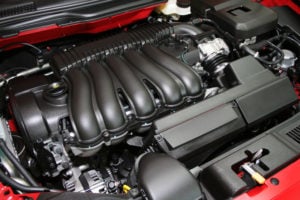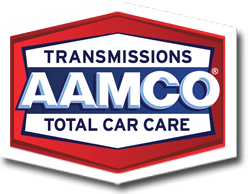It can be difficult to tell if your timing belt is worn out.
Your car’s timing belt is sealed in its own housing, which makes it extremely difficult to check on your own. Timing belts should be left to expert mechanics who have experience dealing with them. An experienced mechanic will know the tell-tale signs of wear, as well as other potential issues that could be affecting the timing belt’s condition, operation, and other engine systems and functions.
Related: Transmission Problems You Should Not Ignore
What does a timing belt do, anyway?
In a nutshell, your engine won’t run without a fully functional timing belt.
 The timing belt rotates the engine’s cam and crankshaft in sync to ensure each cylinder fires at the right time. The timing belt controls the action of the pistons and valves inside the engine cylinders to ensure the valves open in perfect time with the pistons. If this timing is off, the engine will run erratically, if it runs at all.
The timing belt rotates the engine’s cam and crankshaft in sync to ensure each cylinder fires at the right time. The timing belt controls the action of the pistons and valves inside the engine cylinders to ensure the valves open in perfect time with the pistons. If this timing is off, the engine will run erratically, if it runs at all.
The timing belt is usually located inside a housing, or cover, that protects it from all the oil, grime, and dirt that can flow into and around an engine compartment. It’s usually made of industrial-strength rubber with nylon-reinforced cords inside. It is subject to a lot of stress and strain as it works to keep things moving, all regulated in proper time. Even though it’s made to last, it will need to be replaced eventually.
Rubber timing belts are found in the vast majority of engines found in small cars and SUVs, particularly 4 cylinder – but some cars don’t have timing belts. In larger engines that put out more power the timing belt is replaced with a timing chain, which looks much like a bicycle chain. Metal chains serve the same purpose as belts but last a lot longer. Some manufacturers recommend changing the chain at certain intervals, but not the same as for rubber timing belts. Some manufacturers state that the chain does not need to be replaced and will last as long as the car. The downside to chains is that if they fail, they cause a lot more damage than a rubber belt failure. Either scenario is not good, and both can require costly repairs – but a failed timing belt might only result in engine header repairs, whereas a failed timing chain might require a complete engine replacement (or a new car, if you prefer).
Now that you understand the importance of timing belts…
How do you tell if it’s about to fail?
Even though it’s difficult to get at the timing belt to do a visual or physical check, there are some signs you can be aware of that hint at trouble with the timing belt. Pay attention to these indicators so you don’t end up with costly repairs or, worse yet, a ruined engine.
Ticking or clicking noises in the engine.
When the timing belt wears out, it can cause a ticking or clicking sound to emanate from the engine. Because the belt is attached through a series of pulleys to the engine’s cam and crankshaft, and those complex systems are regulated by the timing belt, if something is amiss on either side – belt or cam/crankshaft – this sound is an indicator of trouble. This sound can also indicate low oil pressure, which in turn can affect the timing belt. There is a tensioner that keeps the belt taut, and that tensioner is pressurized by the engine oil. If the tensioner has no oil pressure, the belt will become loose and possibly disengage from the pulleys and/or break. Additionally, if the camshafts don’t have enough to operate properly, they will lock up, which can cause the timing belt to break.
Engine runs rough or misfires.
 A worn-out belt will affect the engine’s timing, and possibly cause it to misfire. As mentioned earlier in the article, the timing belt controls the precisely timed action of the pistons and valves inside the engine cylinders to ensure the valves open in unison with the pistons. If the belt is worn or loose, it will slip and cause cylinders to open and close earlier than they should. If this timing is off, the engine will run erratically, if it runs at all. Engine misfiring is a sign of trouble that should be checked as soon as possible, otherwise you are risking serious engine damage.
A worn-out belt will affect the engine’s timing, and possibly cause it to misfire. As mentioned earlier in the article, the timing belt controls the precisely timed action of the pistons and valves inside the engine cylinders to ensure the valves open in unison with the pistons. If the belt is worn or loose, it will slip and cause cylinders to open and close earlier than they should. If this timing is off, the engine will run erratically, if it runs at all. Engine misfiring is a sign of trouble that should be checked as soon as possible, otherwise you are risking serious engine damage.
Engine won’t start.
There are a lot of reasons your car won’t start, and a broken timing belt is one of the more costly ones. Fortunately, it’s difficult to ignore the problem of your car not starting, so the chances of the timing belt being diagnosed as the cause is much better than if you keep driving and ignore the problem until it became critical. Of course, if the timing belt breaks while you’re driving, you definitely notice! But simply put, a broken timing belt means the car will not start, and there is possibly other damage to the engine. The starter motor will engage, but the car won’t turn over – it won’t even tease you, there will be no response. Some damage that might occur can be to the cylinder heads, as well as to the crankshaft bearings, oil pump or water pump.
Related: My Check Engine Light Is On
Squealing sounds.
The squealing might occur at different times, such as accelerating, decelerating and braking, or just idling. Whenever that annoying sound occurs, it’s something to pay attention to and have checked out by a mechanic. There are a few possible causes for such noises to be coming from your car, and all of them might mean repairs – but if it’s a worn out timing belt on the verge of breaking, it’s best to know! Take your car to a mechanic right away.
Related: Reasons Your Car is Squealing
 AAMCO Colorado Can Diagnose and Fix Your Timing Belt
AAMCO Colorado Can Diagnose and Fix Your Timing Belt
Visit an AAMCO Colorado transmission repair and total car care center near you. When issues arise and you need to have your timing belt checked or replaced, as well as any repairs needed due to damage from a broken timing belt, book an appointment.
Ask an AAMCO Colorado Mechanic
If you have questions about your car’s road readiness, or about car repair and maintenance topics, AAMCO Colorado can help. You can also go online and use the AAMCO Colorado Ask a Mechanic feature to submit your auto repair questions. They will be answered by a real AAMCO Colorado mechanic as soon as possible.
Other Articles About Car Maintenance & Repair
My Car Rolls When I Put It In Park
If you have an automatic transmission, you expect your car to stay in place when you put it in park. If your car rolls when in park, or your transmission is slipping or you’re experiencing other issues, bring your car to AAMCO for a complete Vehicle Courtesy Check. This will help identify any possible issues that need to be repaired. Read more…
Change Your Transmission Filter
A transmission filter prevents dirt and debris from getting into the gears and other parts of the transmission system. It is positioned above the transmission pan, which collects excess fluid, and below the pickup tube that connects to the oil pump, which regulates the pressure of fluid in the transmission. Read more…
Why Does My Car Shake When Stopped or Idling?
Your car should run smoothly, whether moving or stopped. If it shakes while it idles, you could be in for a visit to the mechanic. When your car is functioning properly it should run smoothly in all driving modes – moving fast, slowly, stopped and idling. A sign that the engine needs to be checked, and possibly need some repairs, is when your car shakes as it idles.
Read more…

 AAMCO Colorado Can Diagnose and Fix Your Timing Belt
AAMCO Colorado Can Diagnose and Fix Your Timing Belt